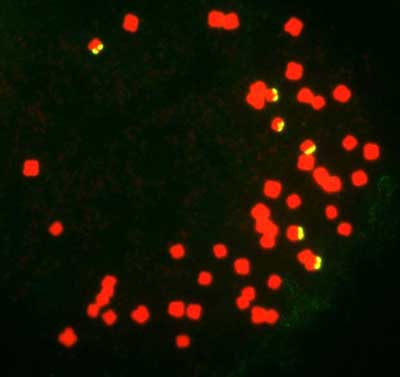Issue 3 Table of Contents

|
FEATURED ARTICLEBreeding and Genetics Development of an Improved Method of Mitotic Metaphase Chromosome Preparation Compatible for Fluorescence in situ Hybridization in Cotton Ryan J. Andres, and Vasu Kuraparthy
Pages: 149-156
Abstract
| Full Text PDF (985K)
Cover page shows the Fluorescence in situ hybridization (FISH) of ribosomal DNA sequences on cotton mitotic metaphase chromosomes. In this issue, researchers report the development of an improved method of mitotic metaphase chromosome preparation compatible for molecular cytogenetic analysis in cotton.
|
|---|
Issue Editors
|
Agronomy and Soils
Investigation of Physiological Growth, Fiber Quality, Yield, and Yield Stability of Upland Cotton Varieties in Differing Environments Matthew S. Wiggins, Brian G. Leib, Thomas C. Mueller, and Christopher L. Main
Pages: 140-148 Abstract
| Full Text PDF (381K)
Breeding and Genetics
Development of an Improved Method of Mitotic Metaphase Chromosome Preparation Compatible for Fluorescence in situ Hybridization in Cotton Ryan J. Andres, and Vasu Kuraparthy
Pages: 149-156 Abstract
| Full Text PDF (985K)
Breeding and Genetics
Gains in Breeding Upland Cotton for Fiber Quality Vasu Kuraparthy, and Daryl T. Bowman
Pages: 157-162 Abstract
| Full Text PDF (427K)
Breeding and Genetics
Inheritance and Transfer of Thrips Resistance from Pima Cotton to Upland Cotton Jinfa Zhang, Hui Fang, Huiping Zhou, S. E. Hughs, and Don C. Jones
Pages: 163-169 Abstract
| Full Text PDF (257K)
Economics and Marketing
Panel Data Analysis of U.S. Cotton Yields for 2002-2011 Archie Flanders
Pages: 170-173 Abstract
| Full Text PDF (344K)
Engineering and Ginning
Changes in Cotton Gin Energy Consumption Apportioned by 10 Functions Paul A. Funk, Robert G. Hardin IV, S. Ed Hughs, and J. Clif Boykin
Pages: 174-183 Abstract
| Full Text PDF (356K)
Molecular Biology and Physiology
18S and ITS1 Genomic Sequence Variations in Rotylenchulus reniformis Isolates from Alabama Seloame T. Nyaku, Ramesh V. Kantety, Yonathan Tilahun, Kathy S. Lawrence, Khairy M. Soliman, Ernst Cebert, and Govind C. Sharma
Pages: 184-194 Abstract
| Full Text PDF (534K)
|
Textile Technology
Feasibility of Visible and Near Infrared Spectroscopy in the Determination of Cotton Trash Components Yongliang Liu, and Devron Thibodeaux
Pages: 195-201 Abstract
| Full Text PDF (435K)
Textile Technology
Portable Color Spectrophotometer Measurements of Cotton Color in Remote Locations James Rodgers, Gustave Schild, Xiaoliang Cui, and Christopher Delhom
Pages: 202-211 Abstract
| Full Text PDF (729K)
Weed Science
Weed Response to 2,4-D, 2,4-DB, and Dicamba Applied Alone or with Glufosinate Rand M. Merchant, Lynn M. Sosnoskie, A. Stanley Culpepper, Lawrence E. Steckel, Alan C. York, L. Bo Braxton, and Jill C. Ford
Pages: 212-218 Abstract
| Full Text PDF (254K)
Weed Science
Evaluation of WideStrike® Cotton (Gossypium hirsutum L.) Injury from Early Season Herbicide and Insecticide Tank Mixes Scott D. Stewart, Lawrence E. Steckel, and Sandy Steckel
Pages: 219-226 Abstract
| Full Text PDF (257K)
Weed Science
Cotton Yield Loss Potential in Response to Length of Palmer Amaranth (Amaranthus palmeri) Interference A. W. MacRae, T. M. Webster, L. M. Sosnoskie, A. S. Culpepper, and J. M. Kichler
Pages: 227-232 Abstract
| Full Text PDF (331K)
Agronomy and Soils
NOTE Growth and Physiological Responses of Five Cotton Genotypes to Sodium Chloride and Sodium Sulfate Saline Water Irrigation Genhua Niu, Denise Rodriguez, Jane Dever, and Jinfa Zhang
Pages: 233-244 Abstract
| Full Text PDF (331K)
|
Errata
A Scan Level Cotton Carbon Life Cycle Assessment: Has Bio-Tech Reduced the Carbon Emissions from Cotton Production in the USA?
L. Lanier Nalley, Diana M. Danforth, Zara Niederman, and Tina Gray Teague
J. Cotton Sci. 17(2): 80-88
J. Cotton Sci. 17(2): 80-88
Pages: 80-88
Abstract | Full Text PDF(451K)
